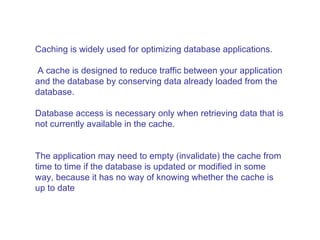
10 Cache Implementation
- 1. Caching is widely used for optimizing database applications. A cache is designed to reduce traffic between your application and the database by conserving data already loaded from the database. Database access is necessary only when retrieving data that is not currently available in the cache. The application may need to empty (invalidate) the cache from time to time if the database is updated or modified in some way, because it has no way of knowing whether the cache is up to date
- 2. Hibernate uses two different caches for objects: first-level cache and second-level cache. First-level cache is associated with the Session object, while second-level cache is associated with the Session Factory object By default, Hibernate uses first-level cache on a per-transaction basis. Hibernate uses this cache mainly to reduce the number of SQL queries it needs to generate within a given transaction. For example, if an object is modified several times within the same transaction, Hibernate will generate only one SQL UPDATE statement at the end of the transaction, containing all the modifications.
- 3. To reduce database traffic, second-level cache keeps loaded objects at the Session Factory level between transactions. These objects are available to the whole application, not just to the user running the query. This way, each time a query returns an object that is already loaded in the cache, one or more database transactions potentially are avoided.
- 4. Caches are complicated pieces of software, and the market offers quite a number of choices, both open source and commercial. Hibernate supports the following open-source cache implementations out-of-the-box: EHCache (org.hibernate.cache.EhCacheProvider) OSCache (org.hibernate.cache.OSCacheProvider) SwarmCache (org.hibernate.cache.SwarmCacheProvider) JBoss TreeCache (org.hibernate.cache.TreeCacheProvider
- 5. Each cache provides different capacities in terms of performance, memory use, and configuration possibilities: EHCache is a fast, lightweight, and easy-to-use in-process cache. It supports read-only and read/write caching, and memory- and disk-based caching. However, it does not support clustering. OSCache is another open-source caching solution. It is part of a larger package, which also provides caching functionalities for JSP pages or arbitrary objects. It is a powerful and flexible package, which, like EHCache, supports read-only and read/write caching, and memory- and disk-based caching. It also provides basic support for clustering via either JavaGroups or JMS.
- 6. SwarmCache is a simple cluster-based caching solution based on JavaGroups. It supports read-only or nonstrict read/write caching (the next section explains this term). This type of cache is appropriate for applications that typically have many more read operations than write operations. JBoss TreeCache is a powerful replicated (synchronous or asynchronous) and transactional cache. Use this solution if you really need a true transaction-capable caching architecture
- 7. Caching Strategies Once you have chosen your cache implementation, you need to specify your access strategies. The following four caching strategies are available: Read-only: This strategy is useful for data that is read frequently but never updated. This is by far the simplest and best-performing cache strategy. Read/write: Read/write caches may be appropriate if your data needs to be updated. They carry more overhead than read-only caches. In non-JTA environments, each transaction should be completed when Session.close() or Session.disconnect() is called. Nonstrict read/write: This strategy does not guarantee that two transactions won't simultaneously modify the same data. Therefore, it may be most appropriate for data that is read often but only occasionally modified. Transactional: This is a fully transactional cache that may be used only in a JTA environment.
- 8. Cache Configuration To activate second-level caching, you need to define the hibernate.cache.provider_class property in the hibernate.cfg.xml file as follows: <hibernate-configuration> <session-factory> ... <property name="hibernate.cache.provider_class"> org.hibernate.cache.EHCacheProvider </property> ... </session-factory> </hibernate-configuration>
- 9. You can activate second-level caching classes in one of the two following ways: 1. You activate it on a class-by-class basis in the *.hbm.xml file, using the cache attribute: <hibernate-mapping package="com.wakaleo.articles.caching.businessobjects"> <class name="Country" table="COUNTRY" dynamic-update="true"> <meta attribute="implement-equals">true</meta> <cache usage="read-only"/> ... </class> </hibernate-mapping>
- 10. 2. You can store all cache information in the hibernate.cfg.xml file, using the class-cache attribute: <hibernate-configuration> <session-factory> ... <property name="hibernate.cache.provider_class"> org.hibernate.cache.EHCacheProvider </property> ... <class-cache class="com.wakaleo.articles.caching.businessobjects.Country" usage="read-only" /> </session-factory> </hibernate-configuration>
- 11. Next, you need to configure the cache rules for this class. you can use the following simple EHCache configuration file: <ehcache> <diskStore path="java.io.tmpdir"/> <defaultCache maxElementsInMemory="10000" eternal="false“ timeToIdleSeconds="120“ timeToLiveSeconds="120" overflowToDisk="true“ diskPersistent="false“ diskExpiryThreadIntervalSeconds="120" memoryStoreEvictionPolicy="LRU" /> <cache name="com.wakaleo.articles.caching.businessobjects.Country" maxElementsInMemory="300“ eternal="true" overflowToDisk="false" /> </ehcache>
- 12. Using Query Caches In certain cases, it is useful to cache the exact results of a query, not just certain objects. To do this, you need to set the hibernate.cache.use_query_cache property in the hibernate.cfg.xml file to true, as follows: <property name="hibernate.cache.use_query_cache">true</property>
- 13. Then, you use the setCacheable() method as follows on any query you wish to cache: public class CountryDAO { public List getCountries() { return SessionManager.currentSession() .createQuery("from Country as c order by c.name") .setCacheable(true) .list(); } }
